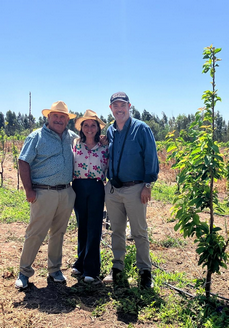Dr. Viviana Curzel, a researcher and technician specializing in stone fruit with low chill hour requirements (CIF Jujuy-FCA UNJu), and Oscar Machuca, a producer of extra-early stone fruit in the region, obtained the first fruit for harvest on September 24. This fruit was obtained as part of a study being carried out in the province of Jujuy by the Mendoza company Güizzo Frutas Frescas SA.

This is several weeks earlier than the earliest cherry productions of Güizzo in Mendoza (Argentina) and the fields in Ovalle (Coquimbo, Chile), which are focusing their efforts on harvesting around week 42, in the middle of October.
The study focuses on a young experimental block of 2,000 cherry trees of different early-producing varieties. The study includes traditional cultivars, such as Brooks and Lapins, but also licensed varieties such as Zaiger (Royal), as well as Nimba and Pacific Red.
The Royal Lee variety (from the Zaiger genetic program) was the first to be ready for harvest on September 24 with soluble solids measurements of up to 21º Brix.
The test block in Monterrico has optimal conditions for growing ultra-early, low to very low HF, short-cycle stone fruit. There are peach, nectarine, and plum cultivars that can be harvested starting the first weeks of September.
The test was implemented in 2022, and the phenology observed in the last 24 months of the study suggests that, with certain cultivars, it is possible to advance the harvest to the last week of September, according to the first results.
Future challenges focus on improving dormancy entry strategies, adjusting the timing of dormancy breakdown, and optimizing the synchronization of varieties, among other aspects, to determine the appropriate agronomic management and the varieties that manifest greater adaptability to the area.
Researchers believe some of the new cherries with low cold requirements that are being developed by genetic programs such as Bloom Fresh, SMS, and Zaiger, which are currently being tested in early areas of Chile and South Africa, could have a great potential for adaptation in this region.
One of the main objectives of this study is to advance the northern Mendoza's harvest window from weeks 42/43 to weeks 39/40.
The temperate valleys of Jujuy, in the interior and extreme north of Argentina, are characterized by mild, short winters and monsoon-type rainfall, which means that the fruit's setting, growth, and development coincide with high heliophany and low rainfall. These characteristics - in addition to making extra-early harvests possible - provide the fruit with high-quality attributes, such as sweetness and color.
For more information:
Dr. Agr. Eng. Viviana Curzel
Prof. Tit. Chair of Fruit Growing
FCA-UNJu - CIF Jujuy
Email: [email protected]
